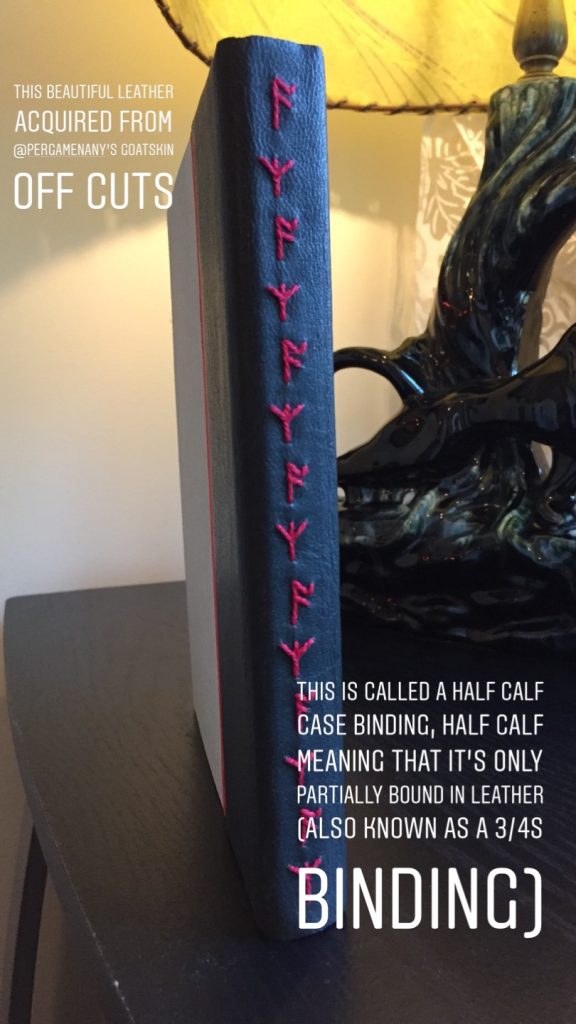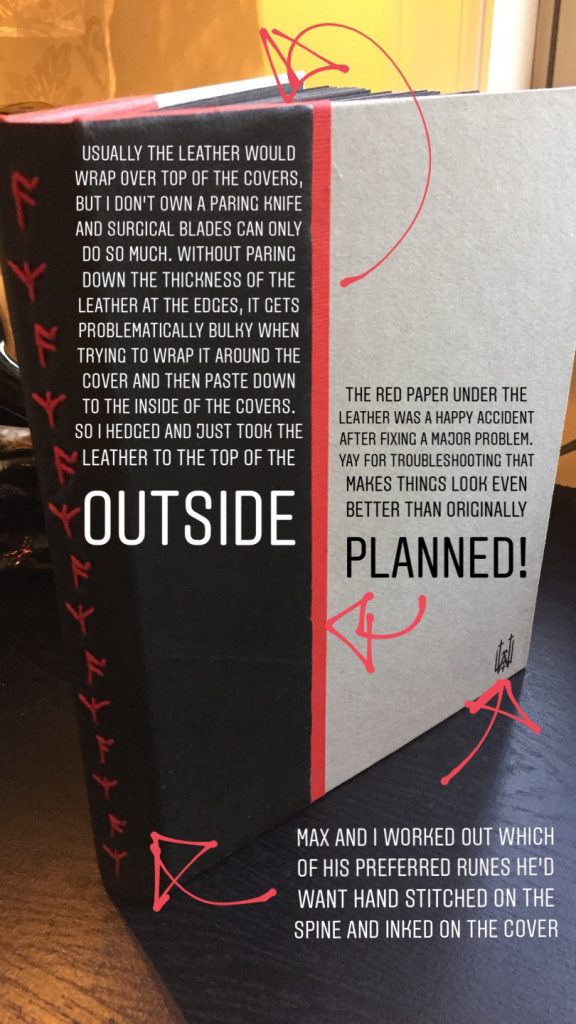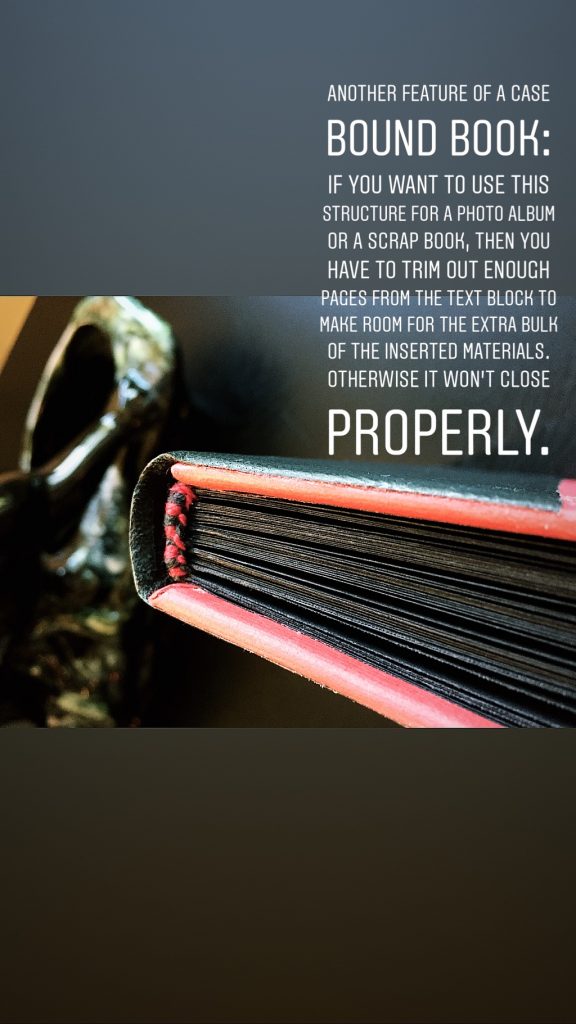
In 2018, Max Shafer of Glenn’s Tattoo Service Inc. in Carrboro, NC asked me to work with him on a custom portfolio. After meeting several times to discuss what functionality and aesthetics he wished for in his book, we settled upon a half calf case binding.
Because Max is a tattooer, he needed a book that was durable and could contain photos. In order to achieve both of these and stay within Max’s desired aesthetic, I modified the case binding to make room for the photos. A standard photo album has a sturdy spine that’s as wide as the book might possibly get if every page were filled with pictures. In order to accommodate the bulk of adding photos and photo corners, I had to trim out parts of or entire signatures, making more room in the spine.
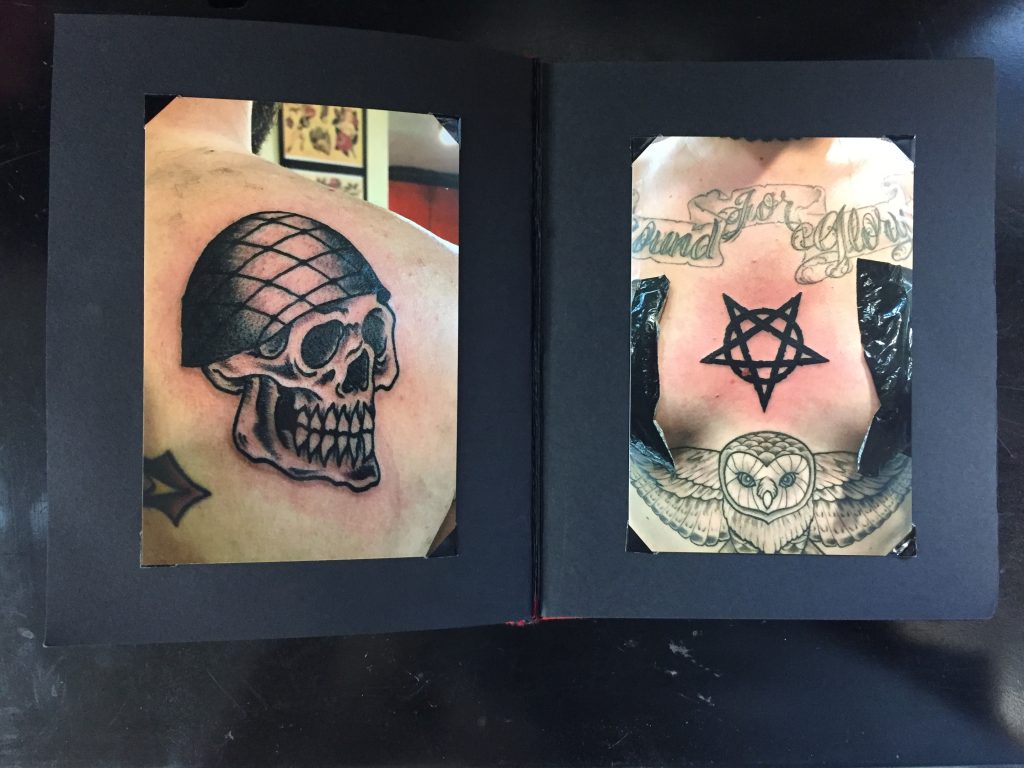
Example of a trimmed out signature 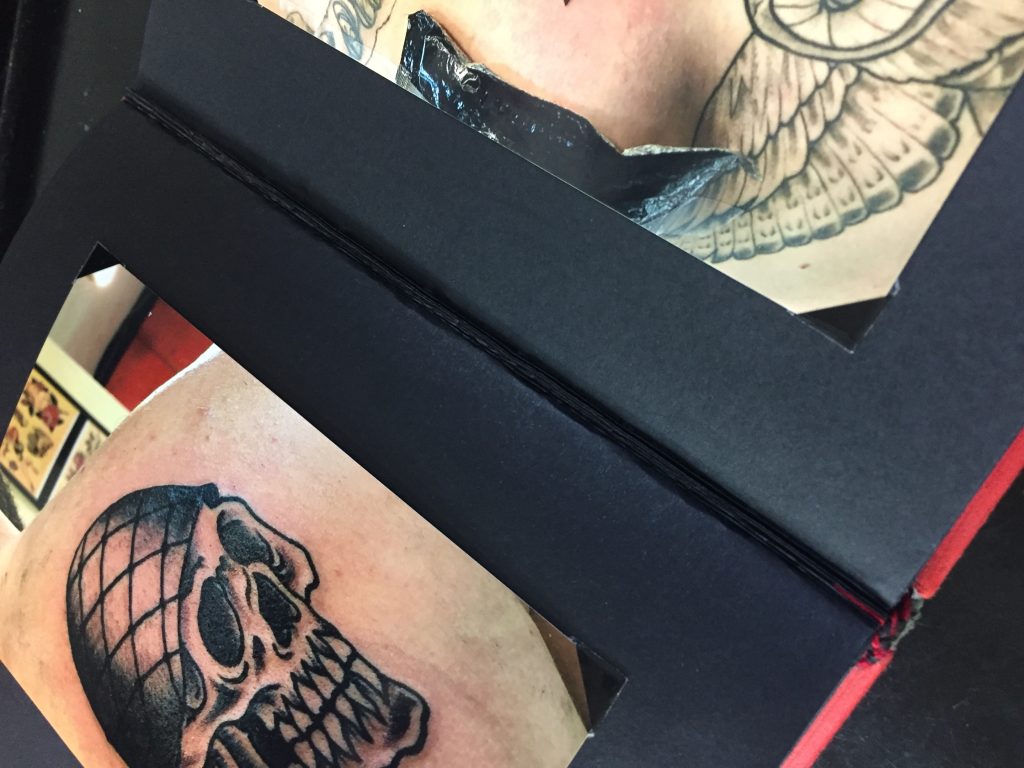
Closeup of the gutter showing the trimmed signature
Now, while this solved one problem, I also knew that the gutter of Max’s portfolio would still experience stress due not just to the bulk of the book and the removed signatures, but also due to the regular and none so gentle turning of the pages by his customers. With this in mind, I let Max know that I’d be back in after the portfolio had seen a month or so of use to doctor up any pages that proved weak. Sure enough, two pages needed a slip of paper pasted into the gutter to secure them back together.

The sigil on the cover of the book, the runes on the spine, and the runes covering the endpapers were selected by Max after I investigated with him which ones would represent the tone he was trying to set with his portfolio. The sigil I hand drew. The endpapers I hand lettered in red ink and painted in red acrylic. The runes I sewed into the leather prior to gluing it to the covers (black goat hide from Pergamena Leather & Parchment’s dyed leather scraps).
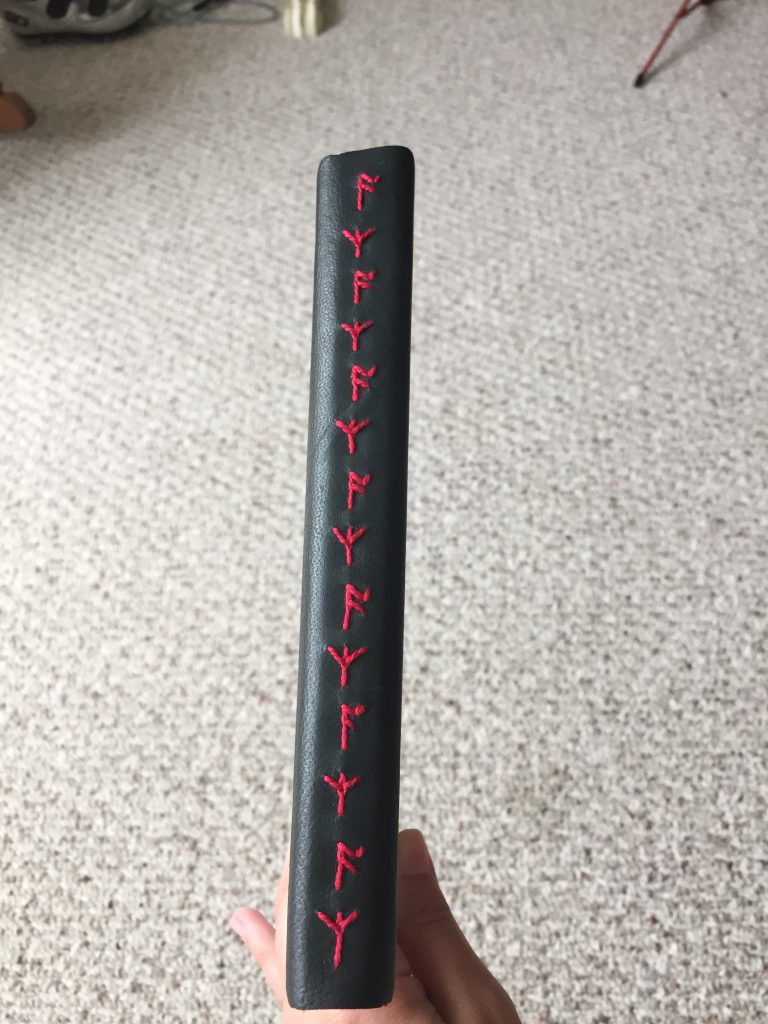
Embroidered spine 
Inked sigil 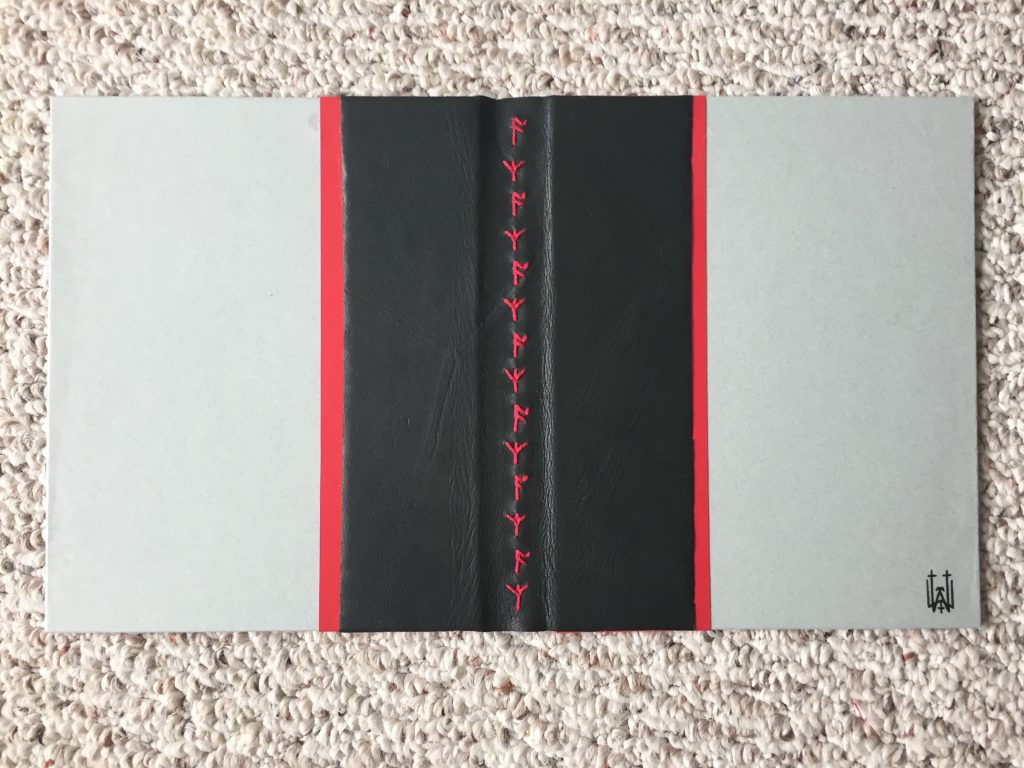
Attached spine and covers 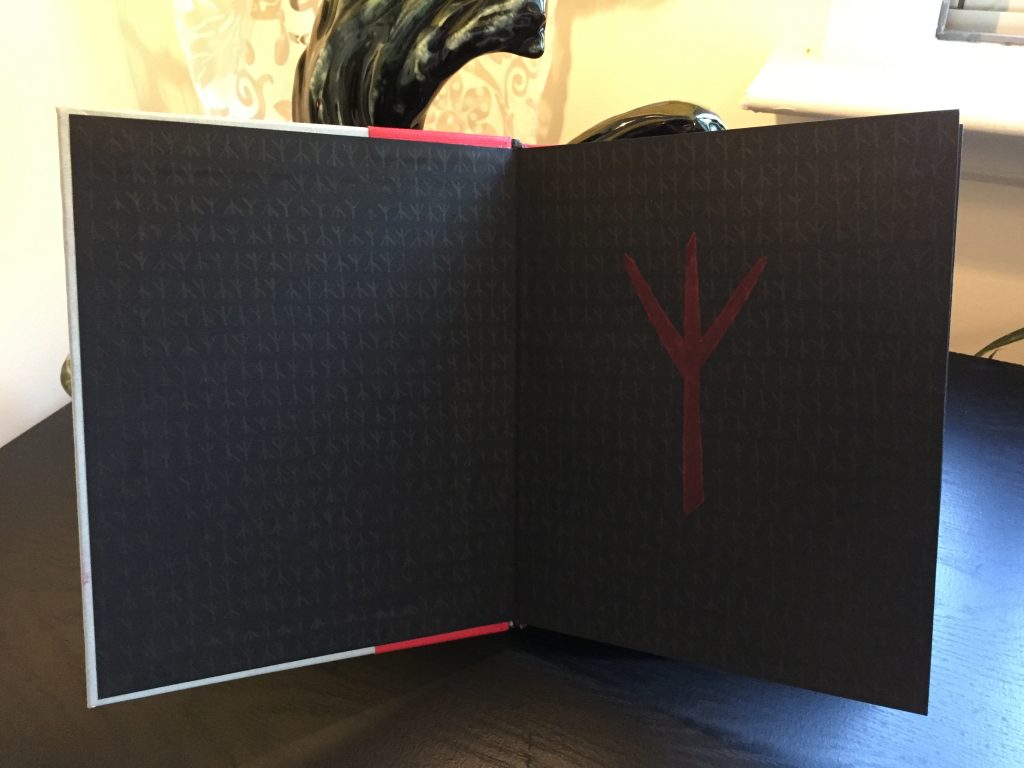
Front cover endpapers 
Back cover endpapers
To further stabilize the book, I also sewed beaded endbands into the head and tail of the spine. These are most often decorative in more modern books, simply pasted along the hidden space between the spine of the textblock and the spine of the covers; however, Max’s portfolio required the added stability of true endbands since the spine was already going to endure rough handling and pressure.
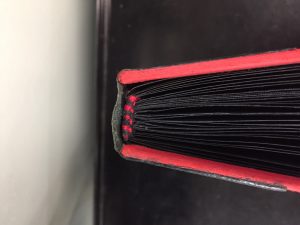
To see the portfolio in its home and in action, check out the following photo and video.
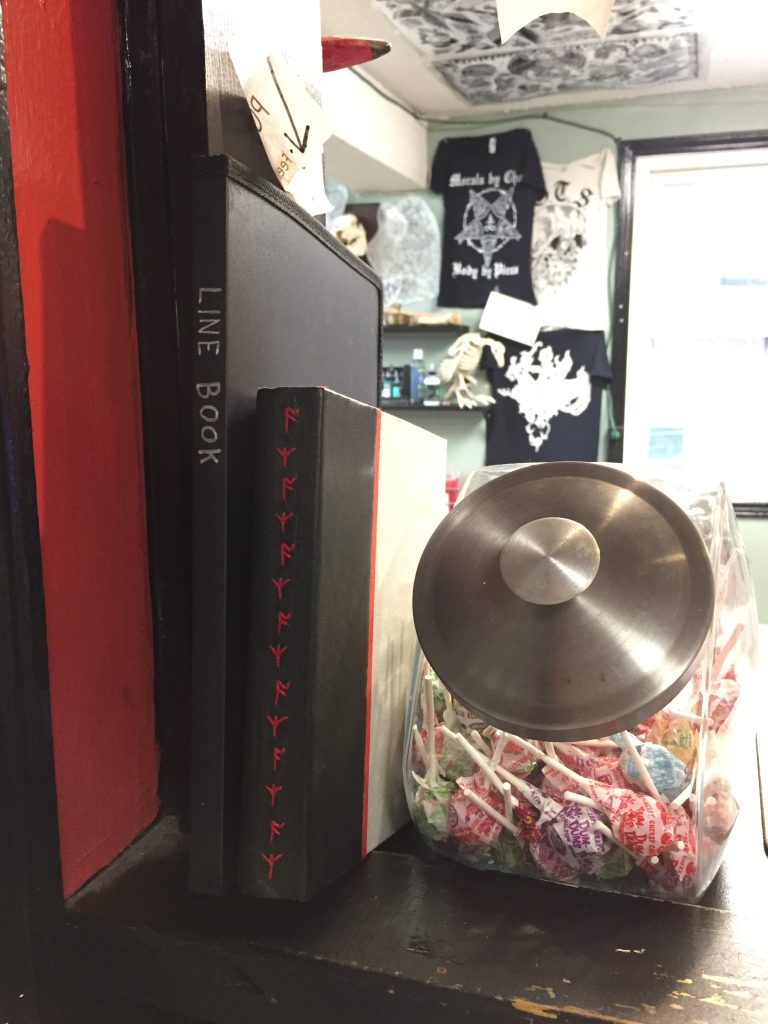
For a mini photo tour of the book, check out the following gallery.
In order to follow along with the transcript or to view the presentation alone, please visit https://docs.google.com/presentation/d/10BDUcSyLaWe8gZDA_1c77mo2cquhUxnaIVVbYKVs2Eo/edit?usp=sharing.
]]>Tailoring the artists’ archives knowledge to a specific artist’s needs has clarified my understanding of the power of organization on an artist’s practice. It has also brought to the fore what is required of an artist-archivist team before even touching the materials to start the archive. First, we have to get at the underlying psychology behind why and how someone naturally organizes. For my artist, Durham letterpress artist Brian Allen, this meant digging down to (1) how he prioritizes, categorizes and uses his materials currently, (2) how he intends to use them in the future and (3) how he naturally arranges this materials.
Establishing existing priorities, categories and uses for studio materials is an essential first step for two main reasons, one being the archival principal of ‘original order’ and the other the long term viability of maintaining the archive…
[For the remainder of the article, see the original blog post published on the Learning from Artists’ Archives initiative’s blog.]
N.B. Image taken from a cropped section of the Physical Storage handout created by Learning from Artists’ Archives fellow Kim Henze on Pictochart.
]]>Authors Neal Ambrose-Smith, Joan E. Beaudoin, Heather Gendron and Eumie Imm-Stroukoff collaborated to create an actionable workbook of best practices based on case studies and studio visits. Between the easy-to-read instructions and well designed worksheets, this workbook will set you on your way to establishing and maintaining a functional, accessible studio archive one step at a time.
For more, see this blog post from the Artist Studio Archives website.
]]>The Georgia O’Keeffe Museum is a single-artist institution dedicated to the life and work of Georgia O’Keeffe (1887-1986). The art collection reflects O’Keeffe’s experience primarily in northern New Mexico, Texas and New York, comprising over 3,000 oil paintings, watercolors and drawings.[1] In addition to her art, the Museum also maintains two historic properties owned by the artist in Abiquiu and on Ghost Ranch, roughly an hour north of Santa Fe.
The Museum recently opened an exhibition on Georgia O’Keeffe’s Far Wide Texas, part of the installation of Becoming A Modern Artist. Portions of the collections are also on loan to the Tate Modern for its upcoming exhibition Georgia O’Keeffe and The Harwood Museum of Art for its exhibition Mabel Dodge Luhan & Company: American Moderns and The West.
Besides the Museum proper and the historic houses, the O’Keeffe campus (as the staff calls it) extends to the Education and Conservation departments, as well as the Research Center, which houses the artist’s Library and Archives. The relationship between Curatorial, the Registrar and the Archives is especially close-knit. Even the interns benefit from this team mentality; staff members throughout the campus have extended invitations for me to shadow them and join their interns for relevant events. As part of this, I will sit in on inter-department staff meetings, join both the Registrar’s interns and the library staff for cataloguing at the historic properties, tour the galleries with Curatorial’s drawing interns, and meet with the director of the Research Center for a glimpse into the planning for an upcoming forum for single-artist institutions.
This year, the Museum focused the arrangement of its galleries around themes, which accommodates display of the personal effects of O’Keeffe, which are the purview of the Archives…[For the rest of the article, please visit the original post published on the Learning from Artists’ Archives blog.]
]]>
Embedded below is a copy of our slides. To see the accompanying text, click the gear symbol and select Open Speaker Notes
]]>I asked the artists six questions:
- Which skills or tools from the workshop have you found most useful to your studio’s organization, artistic practice or personal archive?
- How did the workshop change your attitudes towards maintaining a studio archive?
- What are you struggling with most in terms of your studio archive?
- What do you see as the primary benefit of maintaining your studio archive?
- How have you maintained contact with other artists, archivists or art historians in attendance at the workshop? Has that contact impacted the way you continue to think of your studio archive?
- Are there skills or topics you wish the workshop covered more deeply?…
[For the full article, please see the original post on the Learning from Artists’ Archives blog.]
N.B. Photo taken by Fannie Ouyang, one of the Learning from Artists’ Archives fellows at UNC.
]]>The group is diverse in their mediums, backgrounds and archival needs. They have various expectations for what they will learn, from how to archive without a computer to how to archive their Web presence.
Alberto Ortega Rodas, for example, is a mid-career painter particularly interested in the documentation of artistic process. While his finished work is painting, a large part of his process involves multiple media: photography, digital image processing and digital sketching. These media allow him to “explore lighting situations and to envision paintings and to spark ideas.” The resulting digital images form an archive of their own, separate from the paintings, to which he refers frequently. The difficulty Alberto Ortega Rodas finds in researching other artists’ inspirations and holistic practices inspires his interest in ensuring documentation of his own to assist other artists or researchers.
Beyond his interest in documenting process, Alberto Ortega Rodas also hopes to learn more about image, storage and sale inventories for his paintings, as well as appraisal and disposition of his documentation and materials…[For the rest of the article, please visit the original post published on the Learning from Artists’ Archives blog.]
N.B. Image of slide taken from the workshop’s welcome presentation given by Heather Gendron, formerly UNC’s art library and PI on Learning from Artists’ Archives and now art librarian for Yale University.
]]>